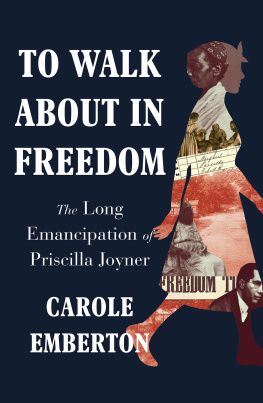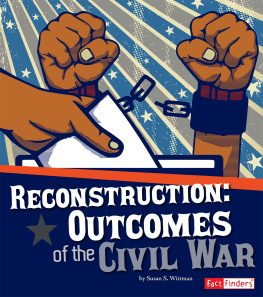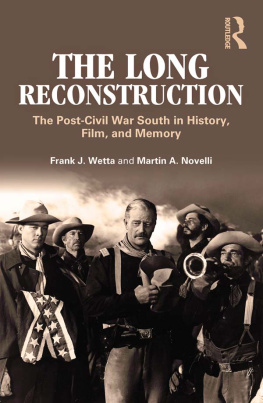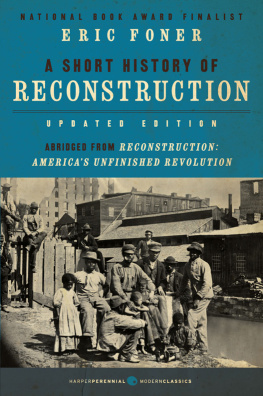Published by Louisiana State University Press
Copyright 2017 by Carole Emberton and Bruce E. Baker
All rights reserved
Manufactured in the United States of America
First printing
DESIGNER: Michelle A. Neustrom
TYPEFACE: Sina Nova
PRINTER AND BINDER: McNaughton & Gunn, Inc.
LIBRARY OF CONGRESS CATALOGING-IN-PUBLICATION DATA
Names: Emberton, Carole, editor. | Baker, Bruce E., editor.
Title: Remembering Reconstruction : struggles over the meaning of Americas most turbulent era / edited by Carole Emberton and Bruce E. Baker ; Introduction by W. Fitzhugh Brundage.
Description: Baton Rouge : Louisiana State University Press, 2017. | Includes index.
Identifiers: LCCN 2016044793| ISBN 978-0-8071-6602-4 (cloth : alk. paper) | ISBN 978-0-8071-6603-1 (pdf) | ISBN 978-0-8071-6604-8 (epub) | ISBN 978-0-8071-6605-5 (mobi)
Subjects: LCSH: Reconstruction (U.S. history, 18651877)Historiography. | Collective memory.
Classification: LCC E668 .R426 2017 | DDC 973.8dc23
LC record available at https://lccn.loc.gov/2016044793
The paper in this book meets the guidelines for permanence and durability of the Committee on Production Guidelines for Book Longevity of the Council on Library Resources.

Introduction
W. FITZHUGH BRUNDAGE
Had the freed people of the American South given a name to the postwar era they might have called it Jubilee. Like the Old Testament Jubilee, when slaves were freed, debts forgiven, and Gods mercy was manifest, the freed people discerned in the Civil War and its aftermath a transcendent moment in human history. The injustice of slavery was lifted and now African Americans, to the full extent of their native abilities and in accordance with Gods design, stood poised to participate fully and equally in modern civilization.
The postwar era, however, acquired a less evocative label: Reconstruction. In narrowest terms, President Abraham Lincoln and his contemporaries applied the name to the process of restoring the states of the former Confederacy to the Union. It entailed the litany of federal policies, revisions to state constitutions and laws, and amendments to the federal constitution that subsequent generations of students have been coerced into memorizing. If something less than the Jubilee of the Old Testament, this thicket of acts, laws, and amendments still represented a redefinition of the American state and its relationship with its citizens. No revision of comparable breadth and impact would occur again until the so-called rights revolution of the 1950s and 1960s.
But Americans used the term Reconstruction to describe far more than the political and legal measures involved in reuniting the nation. Unlike many names that subsequently are attached to historical periodsthe antebellum era, for instanceReconstruction was used by contemporaries to demarcate the epoch in which they lived. It extended from the war until the disputed election of 1876 and Redemption, when conservative white southerners regained control of the region. The term suggested an intentional refashioning of the nation; it implied innovation, regeneration, rehabilitation, and reorganization. In a nation marked by a tradition of episodic, gradual, and piecemeal reform, Reconstruction stood out as a historical rupture when blacks experienced rapid and unprecedented empowerment, northerners exercised pervasive influence over southern institutions, white southerners suffered a dramatic diminution of their power within the region and nation, and the southern economy experienced profound upheaval.
That the period of Reconstruction was exceptional was in part a reflection of the extraordinary and far-reaching consequences of the war that preceded it. When considering the Reconstruction era, it is important to begin with the scale of the bloodshed unleashed by the Civil War. An entire generation of men either participated in or was indirectly exposed to its unprecedented violence. Perhaps as many as 3 million men saw duty in the Union and Confederate armies, out of a total population in 1860 of roughly 31.5 million. More than half of the 5.6 million American men of military age served during the war. (By comparison less than one-third of military-age men served during World War II.)
The character of the war also defined the postwar era. Across the South and far from the frontlines, the familiar rhythms of day-to-day life had been broken. Simultaneously the allure of freedom had inspired slaves everywhere in the region to test the limits of their bondage. Although epic battles such as Antietam and Gettysburg loomed large in the memory of the war, swathes of Arkansas, Missouri, Kentucky, Tennessee, and Virginia bore the scars of the brutal guerrilla warfare that had been waged there. And all southerners experienced the severe scarcity of essentials brought on by the conflict. At the wars close, the South was riven by deep divisions; southern courts were clogged with legal wrangling over wartime disputes, and aggrieved southerners took to settling scores through extralegal means. Against this background, whatever peace prevailed after the war was necessarily brittle. Restoring order in the defeated Confederacy and reunited nation was in itself an ambitious and uncertain undertaking.
The architects of the postwar settlement aspired to do more than merely restore order. At the very least, postwar visionaries recognized the need to address the future of both the freed people and the economy of the South. The postwar settlement could not be a restoration of the antebellum order. The wartime process of emancipation unequivocally precluded the revival of slavery even while it otherwise left unresolved the status of former slaves. The postwar settlement also had to address the urgent need for a system of labor to replace slavery and a system of finance to succeed antebellum credit networks. Thus even the most pinched scenario for the postwar order entailed substantial innovation in statecraft, law, and economic affairs.
Republican visions of Reconstruction were far more audacious. While moderate Republicans entertained postwar plans that were far-reaching, the radical wing of the party proposed one of the most imposing programs of social engineering since the nations founding. Moderate and radical Republicans alike believed that under their leadership the United States was finally poised to consolidate its grip over the entire North American continent. With the debate over slavery in the territories resolved by the war, the nation need no longer be riven by intractable regional divisions and cultures. Free labor, progressive civilization, and the modern market could prevail everywhere, fulfilling the promise of American civilization. Reconstruction would establish the nation on a more secure, modern, and progressive foundation than had the revolution concluded by the nations founders. We do not have to subscribe to white southern critiques of Reconstruction to recognize that the Republican vision for the postwar nation was extravagantly ambitious, even utopian.
For other Americans, especially former Confederates, the postwar reconstruction they had in mind was much less sweeping in scope. Some hankered for a reconstruction, to the extent possible, of the antebellum order. Others acknowledged that the war and emancipation rendered any resurrection of the old order impossible, but they envisioned no more than incremental change to southern institutions. Above all, most were committed, even to a greater degree than many had been before the war, to regional autonomy. The cohesive national economy and polity that Republicans strove to fashion was anathema. For conservative white southerners especially, Reconstruction was the crucible of a new regional identity. Indeed, conservative southern whites would derive a greater source of racial and regional unity in response to Reconstruction than the Confederacy or the Civil War had ever fostered.












